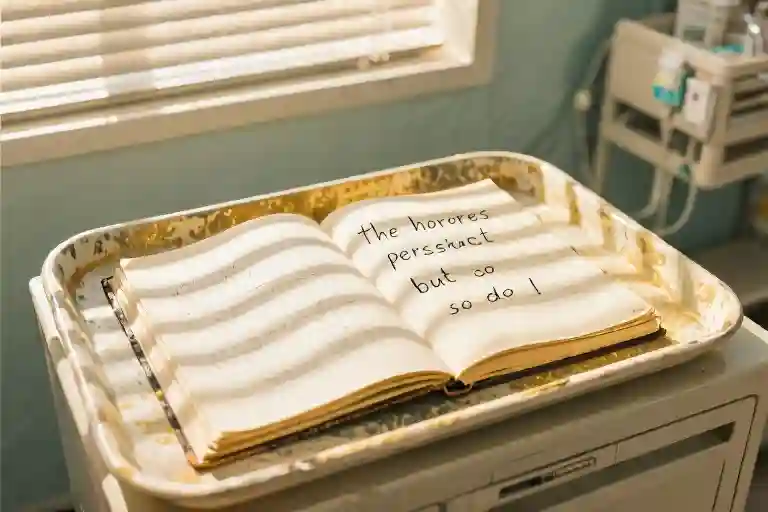The corners of your mouth lift in practiced ease while your fingers tremble against the coffee cup—another morning where the smile fits perfectly, where no one suspects the riptide pulling beneath your calm surface. This is the silent dance of high-functioning struggle: performing competence while privately tallying the costs of emotional labor no paycheck covers.
Office lights hum overhead as you delegate tasks with steady authority, the dependable one who “never gets overwhelmed.” Family dinners find you listening intently to others’ problems, your own carefully shelved away. The duality exhausts you—this life where you’re both the pillar everyone leans on and the person no one thinks to support. When did wearing strength like armor become synonymous with forfeiting the right to be fragile?
Society applauds this version of you—the unshakable professional, the rock-solid friend—while quietly penalizing any cracks in the facade. We’ve confused endurance with invincibility, mistaking someone’s ability to withstand pain for their immunity to it. The cruel irony? The more reliably you shoulder burdens, the less others consider you might need relief.
Your phone fills with messages seeking advice, your desk with projects labeled “only you can handle this.” Meanwhile, that dull pressure behind your sternum grows heavier—not the sharp stab of acute crisis, but the slow compression of deferred needs. Like bricks stacked one by one, each “I’m fine” adds weight until inhaling fully becomes impossible. You’ve become fluent in the dialect of concealed distress: “Just tired” translates to emotionally depleted, “Busy season” means barely keeping panic at bay.
Neuroscience confirms what your body already knows—chronic emotional suppression triggers measurable stress responses. Cortisol floods your system whether you acknowledge it or not. That tension headache? The insomnia? Your physiology sounding alarms your words won’t. We call it silent suffering, but the body always finds ways to scream.
Perhaps most isolating is the temporal disconnect between pain and expression. By the time words form—”I wasn’t okay last month”—the storm has passed, making disclosure feel anticlimactic or even performative. Vulnerability has an expiration date, we assume, and miss the window where it might have mattered. So we file these experiences away as retroactive footnotes to our resilience resumes.
Yet in quiet moments, a rebellious thought surfaces: What if being strong didn’t require disappearance? What if true strength included saying “This hurts” while the wound is still fresh? The cultural script tells us suffering earns its legitimacy through visibility—if no one witnesses your struggle, did it really happen? But your unseen battles still shape you, still deserve recognition.
This introduction isn’t about solutions yet. Before we discuss how to speak, we must acknowledge why silence feels safer. Before rebuilding, we honor what survival has cost you. Your hidden pain isn’t a failure—it’s evidence of incredible endurance. And if nothing else, let these words affirm: someone notices the weight you carry, even if you’ve mastered the art of making it look weightless.
The Silent Sufferer’s Confession
There’s a particular kind of exhaustion that comes from holding yourself together when every fiber wants to fall apart. I know it well—the way your hands steady themselves automatically when your mind is anything but calm, how your voice finds its usual rhythm even as your thoughts scramble for purchase. This is the reality for so many of us who’ve become experts at silent suffering.
The Perfect Breakdown Diary
Monday, 3:17 AM
The numbers on the clock glow faintly as I lie perfectly still. My breathing matches the even rise and fall I’ve practiced for years, but my mind races through tomorrow’s responsibilities. There’s a presentation at 9, my sister needs help moving, and somewhere in between I promised to call a friend going through a divorce. The weight presses down like invisible bricks on my chest—each obligation another layer I can’t seem to shed. My phone lights up with a message: “You’re always so put together—how do you do it?” I type back a smiling emoji and set the phone facedown.
Wednesday, 2:30 PM
In the office bathroom stall, I count to thirty while splashing cold water on my wrists. The meeting went perfectly—too perfectly. When asked about workload, I heard myself say “I’ve got this” with convincing ease. Now my reflection shows what no one else sees: pupils dilated with adrenaline, a slight tremor in my left eyelid. I reapply lipstick like armor and step back into the hallway just as a colleague remarks, “Nothing ever shakes you, does it?”
Saturday, 11:45 PM
Alone in my kitchen, I finally exhale. The week’s performance is over. My hands shake as they grip the counter—delayed reaction to five days of emotional labor. The fridge hums loudly in the quiet apartment. I scroll through photos of friends at a gathering I declined, their captions reading “Wish you were here!” They don’t know I spent the evening staring at a blank TV screen, paralyzed by an exhaustion I can’t name.
Portrait of High-Functioning Struggle
We’re everywhere—the coworkers who volunteer for extra projects while battling insomnia, the friends who remember everyone’s birthdays but forget to eat lunch, the family pillars who organize reunions with shaking hands. Research from the National Institute of Mental Health reveals that nearly 65% of people with depressive symptoms maintain high work performance, their struggles invisible behind competence.
Common traits emerge among silent sufferers:
- The Overcompensation Reflex
Automatically saying “I’m fine” before checking in with yourself. Smiling wider when you feel fragile. Offering help when you need it most. - Emotional Time Delay
Crying about last month’s stressor in the shower. Feeling the full impact of events only after they’re over. - Physical Cryptography
Migraines that appear during downtime. Unexplained muscle tension. Getting sick the day after a big deadline. - Selective Vulnerability
Being able to discuss past pain easily while choking on present needs. Writing eloquently about emotions you can’t voice aloud.
Dr. Eleanor Chen’s study at Stanford identified what she calls “The Caregiver’s Paradox”—the more someone is perceived as emotionally resilient, the less likely they are to receive spontaneous support. “We mistake competence for immunity,” her paper concludes. “But the strongest trees still need water.”
The Unseen Majority
Consider these snapshots:
- Maya, 28, tech team lead: Praised for “thriving under pressure” while secretly tracking her panic attacks in a password-protected note.
- James, 35, single father: Known for “doing it all” as he schedules his therapy appointments during lunch breaks.
- Rebecca, 42, hospice nurse: Called “an angel” by patients’ families, who don’t see her sitting in her car afterward, unable to turn the key.
These aren’t exceptional cases—they’re the norm for millions who’ve internalized that strong people don’t burden others. A UCLA study found that 72% of self-identified ‘caregivers’ go at least two weeks without expressing emotional needs*, even to intimates.
The Silent Contract
We sign this unspoken agreement every day:
I will be your steady ground. I will remember what you forget. I will absorb the chaos. In return, you’ll never have to see me falter.
It sounds noble until you realize the fine print: The less you ask for help, the less others think to offer it. We train people how to treat us, and when we teach them we don’t need support, they graduate from our emotional curriculum.
But here’s what my diary doesn’t show—those rare moments when the mask slips. When a barista asks “How’s your day?” and for half a second, I consider telling the truth. When someone’s unexpected kindness makes my eyes sting. These micro-moments matter because they prove the need exists, even when the words won’t come.
To anyone reading this who recognizes themselves: Your silent struggle doesn’t make you stronger—it makes you human. The bricks you carry are real, even if no one else feels their weight. And though you’ve mastered the art of invisible endurance, you deserve visible support.
Next time you’re alone with your thoughts, try this small rebellion: Whisper “This is hard” to the empty room. No explanations, no qualifications—just three words to honor your truth. The walls won’t judge you for needing more than you can give yourself.
The Unspoken Rules That Keep Us Silent
We live in a world that rewards stoicism and punishes vulnerability. From childhood fairy tales to corporate boardrooms, we’re taught that emotional expression is weakness – unless it’s the socially approved kind. The boy who falls off his bike gets told “big boys don’t cry,” while the girl who voices her needs hears “don’t be so dramatic.” These aren’t just passing comments; they’re the bricks that build what psychologists call emotional armor – that heavy, invisible layer we wear to navigate a society terrified of authentic human fragility.
The Mythology of Strength
Cultural narratives about strength aren’t merely stories – they’re survival manuals. Consider:
- The Provider Trap: Many firstborn children can recall becoming miniature adults by age eight, learning that their role was to comfort rather than be comforted
- Workplace Warrior Culture: 72% of managers in a 2023 Stanford study admitted hiding stress to appear “in control,” fearing emotional transparency would undermine their authority
- Gendered Expectations: Women face the “too emotional” paradox when vulnerable, yet get labeled “cold” when composed – an impossible tightrope walk documented in Harvard’s Emotional Labor Atlas
Our brains have adapted to these social contracts. The amygdala – our threat detection system – registers potential rejection with the same intensity as physical danger. When we consider sharing pain, that almond-shaped neural alarm screams “Danger!” before our rational mind can intervene. It’s not cowardice; it’s evolutionary biology mistaking emotional openness for social suicide.
The Biology of Silence
Neuroscience reveals why verbalizing pain feels like swallowing knives:
- The Freeze Response: Trauma specialist Dr. Bessel van der Kolk explains how unprocessed emotions get “stuck” in the right brain’s nonverbal regions, literally rendering us speechless
- Dopamine Withdrawal: A UCLA study found that people accustomed to being “the strong one” experience actual neurotransmitter depletion when attempting vulnerability – their brains interpret it as role betrayal
- Mirror Neuron Misfire: Our brain cells for empathy often fail to activate for our own suffering – we’re wired to recognize others’ pain more easily than our own
This isn’t just psychological; it’s physiological. The vagus nerve – the body’s emotional superhighway – carries unspoken grief straight to our digestive system, our heartbeat, our muscle tension. That “lump in your throat” when holding back tears? That’s your body manifesting what your mind won’t release.
Breaking the Silence Contract
Recognizing these invisible forces is the first step toward change. Try this reframe: What if speaking your truth isn’t weakness, but the ultimate rebellion against a system that profits from your silence?
- Micro-Disclosures: Start small – swap “I’m fine” for “Today’s been heavy” with a safe person
- Body Whispering: Track physical symptoms (clenched jaw, shallow breathing) as clues to unexpressed emotions
- Permission Slips: Write yourself a note: “I am allowed to need help on (date)” and keep it visible
As researcher Brené Brown reminds us: “Vulnerability is the birthplace of love, belonging, and joy.” Your voice matters – not because it’s perfectly timed or eloquently packaged, but simply because it’s yours. The world needs more honest voices, not more perfectly composed masks.
When Your Body Speaks the Words You Can’t
The tightness in your chest isn’t just stress. That persistent headache isn’t merely fatigue. Your body has been keeping score of every unspoken ache, every swallowed sob, every “I’m fine” that choked its way out of your throat. For those of us who’ve mastered the art of silent suffering, our bodies eventually become unwilling historians of our emotional repression.
The Physical Ledger of Silent Pain
Clinical studies reveal startling connections between suppressed emotions and physical symptoms. Research from Harvard Medical School shows that chronic emotional suppression can increase inflammation markers by 30-40%, directly contributing to:
- Unexplained chronic pain (especially in back, neck, and joints)
- Digestive issues like IBS or recurring nausea
- Skin conditions including eczema and psoriasis flare-ups
- Immune system suppression leading to frequent illnesses
Dr. Elaine Aron’s work with highly sensitive persons (HSPs) demonstrates how unprocessed emotional labor manifests physically. “The body remembers what the mind tries to forget,” she notes in her studies. “Every unexpressed ‘I need help’ gets stored at cellular level.”
Your Silent Suffering Checklist
How much is your stoicism costing you? Mark each that applies:
▢ The Clenched Jaw Chronicles
Waking with sore teeth from nighttime grinding, a physical echo of daytime tensions
▢ The Phantom Weight
That inexplicable heaviness in your limbs, making simple movements feel exhausting
▢ The Revolving Ailments
Mysterious headaches, stomachaches, or muscle pains that migrate without medical cause
▢ The Sleepless Vigil
Eyes wide open at 3 AM while your mind replays every unresolved conversation
▢ The Emotional Allergies
Sudden tears during mundane moments as your body forces emotional release
Scorecard:
1-2: Your body’s sending warning flares
3-4: Distress signals demand attention
5+: Your physiology is waving a red flag
Why Your Body Betrays Your Silence
Neuroscience explains this phenomenon through the polyvagal theory. When we consistently override our need for connection (that “I should handle this alone” reflex), our nervous system gets stuck in a survival loop. The result? Physical symptoms become your body’s only available language.
“It’s not psychosomatic—it’s psycho-physiological,” explains trauma specialist Dr. Bessel van der Kolk. “The body keeps the score because the mind has reached its emotional overdraft limit.”
Breaking the Code of Physical Cries
Your symptoms aren’t flaws—they’re feedback. Try these gentle decoding exercises:
- The Body Scan Interrogation
When pain flares, ask: What emotion might this represent? A stiff neck often carries the weight of unspoken responsibilities - Symptom Journaling
Track physical complaints alongside emotional states. You’ll likely find patterns like migraines after people-pleasing episodes - Preemptive Care
After stressful events, proactively schedule massages or stretching—don’t wait for pain to force self-care
Remember: These aren’t just aches. They’re unvoiced parts of yourself begging for acknowledgment. As psychologist Gabor Maté observes, “The body says what words cannot.” Your symptoms might be the most honest conversation you’ve had in years.
For those who’ve always been the strong one: Your strength isn’t measured by how much pain you can endure silently, but by the courage to let your body’s whispers be heard—before they become screams.
The Whispered Words That Still Count
We’ve been conditioned to believe that asking for help requires grand gestures—tearful confessions, dramatic interventions, or perfectly articulated pleas. But what if healing begins in the quietest moments? That text message sent at 2 AM saying “Can we talk tomorrow?” The scribbled note left on a coworker’s desk: “Had a tough morning.” The half-finished sentence that trails off during a phone call: “I’ve been feeling…”
Gradual Expression: A Ladder Out of Silence
- Digital Whisper (Easiest rung)
- Start with low-pressure mediums:
- A shared playlist with one song titled “How I Feel Today”
- Reacting to a friend’s “How are you?” text with 🟡 (yellow) instead of 🟢 (green)
- Forwarding an article/meme that resonates without commentary
- Partial Disclosure
- Practice “micro-vulnerability”:
- “Work’s been… a lot” (instead of “I’m fine”)
- “Could use some quiet company” (when you can’t say “I’m lonely”)
- “Not my best day” (as code for “I’m struggling”)
- Face-to-Face Fragments (Advanced step)
- Scripts for when words feel dangerous:
- “I don’t need solutions, just need you to know”
- “It’s hard to explain, but my chest feels heavy lately”
- “Can I borrow your hope for a bit? Mine’s running low”
Building Your Safety Net: Spotting the Right Listeners
Look for these often-overlooked traits in potential confidants:
- The No-Drama Responders: People who react to small disclosures with calm curiosity (“Tell me more”) rather than overblown concern (“OMG what happened?!”)
- The Follow-Up Folks: Those who remember your yellow 🟡 text from last week and check in (“Still feeling that way?”)
- The Comfortable Silencers: Individuals who can sit with you wordlessly when you run out of words, without rushing to fill the space
When You’re Not Ready to Speak
Alternative expression channels that still “count”:
- Keeping a shared Google Doc where you occasionally type one raw sentence
- Texting a photo of your unmade bed with no caption
- Playing a song for someone and saying “This is how my insides sound”
“Your smallest truth is still a truth. A whispered ‘not okay’ carries the same weight as a screamed ‘HELP ME’—it just travels differently through the air.”
The First-Aid Kit for Failed Attempts
When vulnerability backfires:
- The Reset Button: “I shared something fragile earlier—can we pretend I didn’t? I’m not ready to discuss.”
- Damage Control: “That came out wrong. What I meant was… [simpler version].”
- Self-Compassion Reminder: Writing yourself a permission slip: “Today I tried. That’s enough.”
This isn’t about transforming into someone who easily shares—it’s about honoring your current capacity while gently stretching its edges. Every stifled “I’m not fine” that makes it past your lips, every hesitant text sent instead of deleted, is a crack in the wall of silence. And light always finds its way through cracks.
Your Voice Matters, Even When It’s Small
We spend lifetimes convincing ourselves that silence is strength. That carrying the weight alone makes us worthy. That our pain must be earned before it can be spoken. But here’s the truth you deserve to hear: Your voice matters—even when it trembles, even when it’s small, even when the storm has passed.
The Courage in Whispering
You don’t need to wait until you’re drowning to reach for a hand. You don’t need to prove your suffering by surviving it alone first. There’s profound courage in whispering “I’m not okay” before the bricks crush your ribs. There’s radical strength in letting someone see your cracks before they become fractures.
For every reader who’s ever:
- Typed and deleted a cry for help three times
- Said “I’m tired” when you meant “I’m breaking”
- Laughed off pain because tears felt too heavy
This is your permission slip: Your pain is valid at Volume 1. You don’t need to amplify it to be heard.
Building Your Safety Net
Start small, but start:
- Swap the script: Next time someone asks how you are, try “Hanging in there” instead of “Fine”
- Find your people: Identify 2-3 “no explanations needed” humans in your life (often fellow silent sufferers)
- Use backdoors: Share a song lyric or meme that hints at your state when words fail
Remember: Vulnerability isn’t all-or-nothing. A whispered truth today makes tomorrow’s confession easier.
Resources for Quiet Warriors
You don’t have to navigate this alone:
- Crisis Text Line: Text HOME to 741741 (24/7 anonymous support)
- The Mighty Community: Online forums for silent strugglers (themighty.com)
- “The Language of Letting Go”: Daily meditations for those who struggle to ask for help
A Promise to Carry Forward
If you take nothing else from these words, take this: Being heard isn’t a privilege you earn by suffering well—it’s a birthright you claim by existing.
The world needs your voice—not just your strength. Not just your survival. Your real, messy, human voice. Because somewhere, someone is waiting to hear it and whisper back: “Me too.”
With you in the quiet places,
Vina
P.S. Your story isn’t over yet. Keep going.





